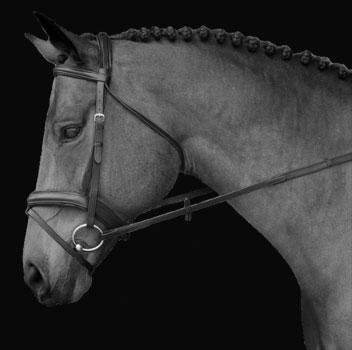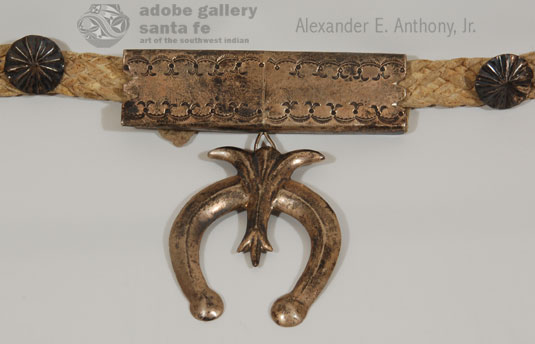Navajo Sterling Silver and Leather Horse Bridle or Headstall with Stand [SOLD]
+ Add to my watchlist Forward to Friend
- Category: Silver Objects
- Origin: Diné of the Navajo Nation
- Medium: Handmade STAND
Leather & Stamped Sterling Silver - Size: Cheek piece 25"
Browband 14-½"; Naja 3" x 2-⅜” - Item # C3966 SOLD
The Diné from the Navajo Nation learned how to work with silver from Mexican silversmiths in the early 19th century. Good smiths created silver objects desired by Mexican and, later, American neighbors, and traded these objects for items they wanted or needed like horses or food. One object that a very talented smith could get a good amount of trade on was a Navajo Sterling Silver and Leather Horse Bridle.
 A Navajo made bridle consists of a crown piece, a browband or headstall, cheek piece and a throat latch. A distinguishing feature of Navajo bridles is the appearance of conchas and a naja. It is believed the concha design was borrowed from the Mexicans. The word concha is Spanish for shell. Originally silver dollars were hammered, then stamped and edged to make conchas to be used in belts, buckles and horse gear.
A Navajo made bridle consists of a crown piece, a browband or headstall, cheek piece and a throat latch. A distinguishing feature of Navajo bridles is the appearance of conchas and a naja. It is believed the concha design was borrowed from the Mexicans. The word concha is Spanish for shell. Originally silver dollars were hammered, then stamped and edged to make conchas to be used in belts, buckles and horse gear.
On a Navajo bridel, conchas can be attached either at the junction of the browband and head stall or on the cheek piece.
This bridle consists of a browband that has a 4-inch stamped silver bar in the center, from which hangs a sandcast naja. On either side of the center band is a silver repoussé button. The junction of the browband and cheek piece is an L-shaped stamped connection. Below the connection is an elaborately stamped concha. The remainder of the cheek piece has two additional silver bars. The first is a stamped bar and the other is a stamped bar with feather-like extensions. In addition, there is a leather piece with 6 silver buttons that was perhaps part of the reins.
A metal stand has been made for proper display of the bridle. It is provided with a pedestal for displaying the bridle on a table. It is also provided with a wall mount bracket for display of the bridle on a wall. The table stand is removable when displaying on a wall and the wall bracket is removable when displaying on a table. The overall stampwork on this piece is precisely done. The maker was extremely talented.
Condition: silver and leather in very good condition
Provenance: this Navajo Sterling Silver and Leather Horse Bridle or Headstall with Stand is from the collection of a client from Nevada to whom we sold this in 1987.
What is a Naja? Early Navajo-made jewelry contained elements that were borrowed directly from Spanish colonial and Mexican ornament. One of these items is the naja, a crescent form of Moorish origin. The Spanish conquerors in the Southwest outfitted their horses in elaborate silver ornaments—one of which was the naja that hung directly on the forehead of the horse as a part of the bridle.
Recommended Reading: American Indian Art Magazine C4354P Vol.2, No. 2, Spring 1977. There is a great article on Navajo Silver Bridles by David L. Newmann in this issue.
Relative Links: jewelry, Navajo, silver objects, conchas, naja, belts

- Category: Silver Objects
- Origin: Diné of the Navajo Nation
- Medium: Handmade STAND
Leather & Stamped Sterling Silver - Size: Cheek piece 25"
Browband 14-½"; Naja 3" x 2-⅜” - Item # C3966 SOLD



